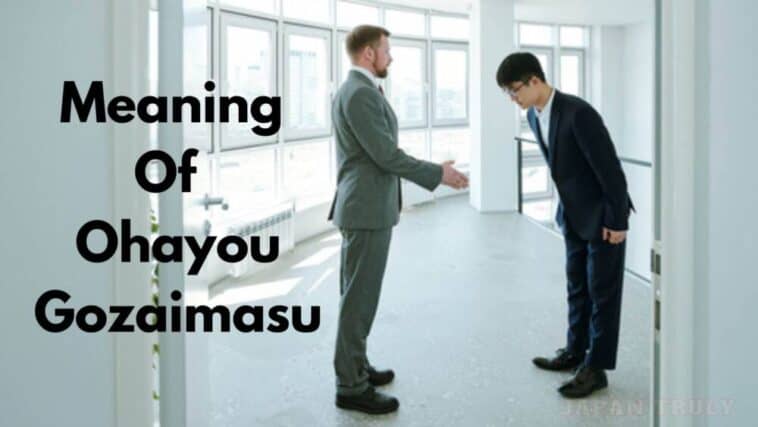Wondering what’s the meaning of Ohayou Gozaimasu in Japanese? Here’s a detailed explanation. Check it out!
If you wish to greet someone, have a Good Morning in Japan, simply say ‘Ohayou Gozaimasu.’ Let me explain this greeting in detail based on its components.
ou hear “Ohayou Gozaimasu” everywhere in Japan, but what does it truly mean? This guide delves beyond “good morning” to explore the politeness levels and cultural significance behind this common greeting.

Page Contents
Meaning Of Ohayou Gozaimasu
You can easily break down ohayou gozaimasu into two parts: ohayou and gozaimasu. Let me explain the details of these two components:

Ohayou – (おはよう) is a Japanese greeting for ‘good morning’. Honestly speaking, we can use this term alone to greet somebody good morning in Japanese. But, it sounds less polite so native speakers use it mainly to greet family members and friends. ‘Ohayou’ originally came from the i-adjective, ‘ohayai’ which can be further broken down into two components:
o – (お) : is a prefix used to make its following word sound polite and respectful. It can also be used in other words like omotenashi, osusume and onamae.
hayai – (早い (はやい): is an i-adjective that means ‘early’ in Japanese.
From the above two components we can now understand that ohayai is the polite expression of hayai which translates into:early. So, the word Ohayou has the same role and meaning.
Gozaimasu – (ございます) : is a Japanese phrase used to express things in a polite way. The native locals will often use this phrase to say they have something in a polite manner. Grammatically, it can be further broken down into the following:
gozai – (ござい) : it is a word originally coming from one conjugation of the verb gozaru which was used to express the existence of things in a very polite way. If you translate it into english it means- to have, to be or to exist.
masu – (ます) : it is an auxiliary verb put after a verb to make it more polite and respectful. In the phrase, it is put after gozai to make it sound more polite.
From the above two components, we can understand that gozaimasu is a polite expression in Japanese for to have, to be and to exist. This is the second part of the phrase ohayou gozaimasu.
- Related: Meaning of Daijoubu
Original Meaning of Ohayou Gozaimasu
So far, I have already explained the components of the phrase and greeting in detail. Naturally, the question comes to mind: what will happen when these components come together? They mean to ‘be early’ or ‘to have’ in a polite manner in Japanese.
But, what does it mean?
It is said that the phrase and greeting Ohayou Gozaimasu originally meant ‘glad to have you here early’. It was used to express gratitude for having someone else at a certain place early in the morning.
Maybe this sounded a little off to the Japanese learners, because the greeting does not have any word referring to a particular place or person.
But, in reality, it is not so weird because we know that a greeting is normally headed to the listener who is at the same place as the speaker is. So the terms ‘you’ and ‘here’ are understood from the context and situation.
Isn’t it obvious that we would be happier with being together with someone than being alone early in the morning?
So, the original meaning and its usage are quite easy to understand. However, today, the greeting is normally translated as ‘good morning’, but the meaning, ‘glad to have you here early’, is always behind it.
- Related: Meaning of Kokoro
How to Say Good Morning in Japanese: Examples
Now let me explain how to use Ohayou Gozaimasu with a common example below:
Ohayou Gozaimasu, Haru san
おはようございます、はるさん
Good morning, Haru san.
Haru – (はる) is a popular female name in Japan and San – (さん) is an honorific suffix added after a name. Here it is used after her name to call her in a polite way.
Ohayou gozaimasu. Kyou mo asa kara atsui desu ne.
おはようございます。今日も朝から暑いですね。
Good morning. Today too, it is hot from the morning.
Ohayou Gozaimasu is not only a way to say good morning, but also can be used to create a certain intimacy and start a conversation about common topics like the weather and the seasons.
How to say Good Morning in Different ways in Japanese
Ohayo Gozaimasu Minna:
When you add the word ‘minna’ or ‘minna san’ before and after the greeting it means when you greet a whole group instead of only an individual. So, the meaning of the phrase Ohayo Gozaimasu Minna is ‘Good Morning, Everyone.”
It can be used by a teacher greeting her students inside the classroom or when you greet your colleagues at work. The subject of the sentence will change depending on the context of the situation.
- Related: Meaning Mono and Koto in Japanese
- Related: Meaning of Ara Ara in Japanese
Ohayo Gozaimasu Genki Desu Ka:
It is often used by people who want to have short conversations with someone after greeting them in the morning, which is a more casual set-up. The phrase directly translates into ‘Good Morning, How are you?’ So, it is best to use this phrase with someone that you have a close relationship with.
So, how can you reply to the above two phrases and greetings?
There is actually no specific reply that should be given even though you can always reply back using the same phrase-ohayo gozaimasu or simple ohayou followed by the word-Daijobudesu which means ‘I am good’ in Japanese.
- Related: Meaning of Ganbatte
Why is it important to learn these greetings in Japanese?
Learning these basic greetings is important and helpful especially if you are visiting Japan for the first time.
In Japan, these simple greetings and phrases are very essential everywhere a traveler goes. You see, this is exactly how a restaurant staff will greet their customers, how strangers slightly bow to one another as a form of greeting or even how a receptionist greets her clients.
There is no denying the fact that Japanese people are so respectful that greetings are just considered a sign of respect. The act of greeting in Japanese is referred to as ‘Aisatsu.’
What most people find surprising about Japanese greetings is the fact that these are strongly embedded into their culture and are even taught to children at a young age, as early as kindergarten. Did you know that teachers are taught how to properly and respectfully greet their teachers. And peers?
Although some may say that this is a non-stop greeting session, what they don’t understand is the fact that these greetings are solely intended to make one feel energetic and happy. This simple act of acknowledgment can come a long way.
Is it Ohayo or Ohayou Gozaimasu?
Both are true and applicable. If you wish to say it to a friend or somebody close, then you can say- Ohayou or Ohayou go. It is a casual or shortened form of the original phrase and so can be used to say good morning in informal occasions. A right example would be a greeting for family, friends, juniors or co-workers.
What are the other common forms of greeting in Japanese?
You can say Konnichiwa which means hello or good day. Another common greeting is Konbanwa (こんばんは) which is used for the late afternoon and evening.
Can you say ‘Ohayo’ at night too?
Ohayo gozaimasu and ohayo are usually used in the morning but sometimes used in the afternoon, evening and night too if you see the person for the first time that day. If you are at work then it is a common greeting irrespective of the time.
How do you respond to someone who says Ohayo Gozaimasu?
When someone greets you in Japanese with the phrase, you can respond back using the same phrase-ohayo gozaimasu. As mentioned before, the casual version is replying with only ‘ohayo.’ Ohayo gozaimasu is a more formal and polite greeting to wish someone in the morning, especially your boss, seniors, elderly people, and strangers.
Conclusion:
As you start studying Japanese, you will come across many greetings and ways to say hello in Japanese. You will also discover the different levels of formality and use of the language.
All you have to do is practise and stick with the general formal phrases. However, if you wish to start looking at more greetings in detail you are always welcome to read up more on it.
Ohayou Gozaimasu is a very important greeting in Japanese because it is the first one said to start your day. And what better way to share some happiness, cheerfulness, and energy to another person?
Hit us up with your thoughts and comments. Don’t forget to share this article with your friends.
Also Read





